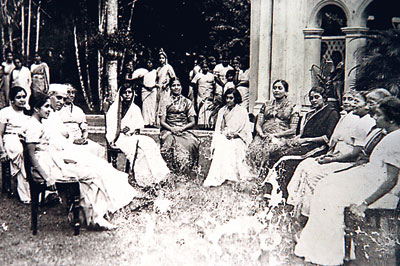The Sri Lanka Tamil Women’s Union celebrates its centenary today. Inaugurated on January 4, 1909, the organisation was set up to encourage the Tamil community to preserve and promote Tamil culture. Tamil civilisation and culture is one of the oldest in the world, and the union has consistently endeavoured to keep alive a love and interest in this ancient heritage.
An English-medium education was a boon to the Tamil community of the north and the east. It opened up avenues of advancement and brought members of the Tamil community out of their traditional homeland to seek their fortune in government service and in the professional fields. This happened during the British period of colonial rule and linked together the Tamils, the Sinhalese, the Muslims and the Burghers as Ceylonese and as a nation.
 |
| This historic photograph records the visit of the Nehru family to Sri Lanka when they met up with the Sri Lanka Tamil Women's Union in 1932. Picture shows Jawaharlal Nehru, Kamala Devi Chatopaudia (next to Nehru, partly covered), Kamala Nehru (wife of Jawaharlal who has her head covered), Indira Nehru (later Gandhi -- seated seventh from the right) and Sarojini Naidu (fifth from the right). |
The education of Tamil women and their emergence from the seclusion of their homes over the past century have brought about far-reaching changes in the social pattern of this country. Educated women in the colonial era were taking their place in society and in the life of the emerging nation, not only as wives and mothers but also as teachers, doctors and lawyers.
In the early 1900s, a Canadian lady, Dr. Mary Helen Irwin Rutnam, arrived in Ceylon. Dr. Mary Irwin was in New York on a medical apprenticeship, where she met a Jaffna Tamil Christian, Samuel Christmas Kanaga-Rutnam, who was doing postgraduate studies at Princeton University. They married in 1896, and the couple came to live in Colombo and Jaffna. Practising as a gynaecologist in Colombo, Dr. Irwin Rutnam had an opportunity to observe the plight of women in Ceylon society. She consequently founded the Girls’ Friendly Society, whose mission was to work for the welfare of the country’s under-privileged women.
Dr. Mary Rutnam saw many young Tamil ladies from Jaffna and the east, married to professionals, move to homes in Colombo and establish their new place in society. Inspired and encouraged by Dr. Rutnam, a group of these women founded the Ceylon Tamil Women’s Union.
A distinctive feature of the Sri Lanka Tamil Women’s Union is that it is a secular organisation. From the outset, it attracted Tamils who are Hindu, Protestant Christian and Catholic as active members.
With the dawn of independence and the cultural renaissance that followed, the Ceylon Tamil Women’s Union launched the Kalalaya School of Dance and Music, on September 1, 1948. This “temple of art”, was a dream come true for the re-named Sri Lanka Tamil Women’s Union.
In the early years Kalalaya was a pioneer institution for teaching oriental dancing in Ceylon, conducting classes in Bharatha Natyam, Manipuri, Kathak and Kathakali. This School of Dance and Music celebrates its diamond jubilee this year.
Extracts from ‘The History of the Sri Lanka Tamil Women’s Union’ by Indira Sathasivam, past president, SLTWU |

